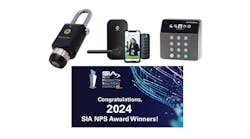In the December issue of Locksmith Ledger (www.locksmithledger.com/12275214), I wrote about code changes that will be incorporated into the 2018 International Building Code (IBC) and the 2018 International Fire Code (IFC). This “new” code language is actually more of a confirmation that classroom doors must comply with the existing requirements – one operation to release the latch, with no key, tool, special knowledge or effort, and no tight grasping, tight pinching, or twisting of the wrist. In addition, the IBC and IFC will require classroom doors to be able to be unlocked from the outside using a key or other approved method.
A similar change is in progress for NFPA 101 – The Life Safety Code, but the language has some key differences from the requirements of the IBC and IFC. This proposal has not yet received final approval, and some of the points will be discussed in June at the annual conference of the National Fire Protection Association (NFPA). Eligible members will have the opportunity to vote on the final language to be included in the 2018 edition of NFPA 101.
In jurisdictions where NFPA 101 has been adopted, it’s crucial for locksmiths to be aware of these proposed changes, which will affect the types of products that are allowed on classroom doors. The new requirements will become effective when a jurisdiction adopts the 2018 edition of NFPA 101; some states and local jurisdictions may make modifications to the model codes which are also important to be familiar with.
Proposed Changes to NFPA 101
If approved, sections will be added to the occupancy chapters that address new and existing schools (chapters 14 and 15), day care centers (chapters 16 and 17), and colleges and universities (chapters 38 and 39). Many of the requirements of the proposed sections are already mandated by the current model codes:
- The lock must not require the use of a key, tool, special knowledge or effort.
- In new buildings, one releasing operation must unlatch the door.
- The releasing mechanism must be located between 34 inches and 48 inches above the floor.
- Modifications to fire door assemblies must comply with NFPA 80.
Some of the proposed changes are consistent with the approved changes to the 2018 IBC and IFC:
- Locks must be able to be unlocked from outside of the room with a key or credential.
- The means of locking the door shall not modify the door closer, panic hardware, or fire exit hardware.
There are proposed changes which are more specific with regard to the classroom locks:
- Classroom doors must be capable of being locked without opening the door.
- The emergency plans must address the use of the locking methods, and the staff must participate in drills to engage and release the locks.
And there is one proposed change – just one little word, actually - that is a major change from the current model codes and is inconsistent with the IBC and IFC changes. This proposed language applies only to existing buildings and would not apply to new buildings: “The releasing mechanism shall open the door leaf with not more than two releasing operations.”
Two Operations vs. One
When I first saw the proposed language, I thought a lot about the current one-operation requirement vs. the proposed two-operation limit for existing buildings. Would allowing two operations reduce the level of safety in our classrooms? Is the trade-off of increased security worth a potential delay in evacuation? What is the motivation for allowing two operations for existing buildings?
I was curious about how long the single-operation language has been part of NFPA 101, since it has been a requirement for as long as I can remember. In fact, the Life Safety Code has required hardware to unlatch with one releasing operation for almost 30 years. I went back as far as the 1927 edition of the Building Exits Code, which requires doors to be “so arranged as to be readily opened.” Similar language still exists in the Life Safety Code today.
The 1985 edition of NFPA 101 required a simple type of releasing device such as a knob, handle, or panic bar, with a method of operation that is obvious, even in the dark. In the 1988 edition, a line was added to quantify the allowable number of operations: “Doors shall be openable with no more than one releasing operation,” with an exception for one additional releasing operation on dwelling units in residential occupancies. The requirement for one releasing operation has been included in the nine editions of the Life Safety Code that have been published since 1988.
Saving Money vs. Saving Lives
So why change now? There is a multitude of code-compliant products that will provide the necessary level of security. There are even ultra-secure products used on exterior doors in urban locations prone to vandalism and theft, which release with one operation. The only reason I can think of for changing to two operations is to allow schools to buy retrofit security products at a lower cost than traditional hardware.
With the rise in school shootings and other school-related incidents, there has been an increased focus on school security in recent years. However, tight budgetary restrictions have caused some school districts to consider the use of retrofit security products, also known as classroom barricade devices, instead of addressing existing locks, key systems, glazing, and security procedures that may not provide a sufficient level of protection.
While it may be less expensive to purchase and install barricade devices on classroom doors, in some cases it may actually cost less to address the existing hardware. The locks might need to be rekeyed and keys distributed to all staff members. Existing glazing can be addressed with security film to delay access through a sidelight or vision light. New protocols, like keeping existing classroom function locksets locked during the school day, could also enhance security at a relatively low cost.
If the existing hardware won’t address a school’s security needs, it’s important to keep life safety code requirements in mind when selecting a new security solution for classroom doors. Lack of attention to the applicable code requirements could result in increased liability for not only the school district, but the supplier and/or installer of the non-compliant products.
Fortunately, there are many products that will provide the needed level of security for classroom doors, and are also compliant with the model codes. Although there are differences of opinion regarding which lock function is preferred – classroom security function, entrance/office function, or an electrified lockset – hardware manufacturers offer a wide range of products that will protect students and staff, and will also comply with the code requirements that ensure free egress, fire protection, and accessibility for all building occupants.
If It Ain’t Broke…
Currently, the model codes allow two releasing operations for the entrance door to a dwelling unit or sleeping unit. This seems reasonable, because the person who may have to disengage the locks for egress is probably the same person who engaged the locks and is familiar with the method required to do so. In contrast, a student attempting to remove a retrofit security device in order to evacuate a classroom may not know how to disengage a locking device that was installed by the teacher.
NFPA 101 currently includes another exception where two releasing operations are allowed – when existing hardware is installed on a door that is serving a room with an occupant load of 3 people or less. The occupant load of an average classroom is obviously well over 3 occupants. I’m unsure about the justification for this jump from 3 occupants to 30 or more, especially when most of those occupants are children.
Although it may be tempting to overlook accessibility when securing a door against unwanted entry, classroom doors are not exempt from the requirements that apply to doors on an accessible route. The accessibility standards require hardware to be operable with one hand, and no tight grasping, pinching, or twisting of the wrist; the proposed change to NFPA 101 does not include this requirement, and this creates a conflict with the accessibility standards. To ensure that classroom doors are usable by everyone, these standards must apply at all times – during normal operation, and when the door is secured.
There’s another important consideration regarding this proposed language. In the chapters for educational and day care occupancies, the code change proposal stipulates that the requirements would apply to classroom doors in those facilities. College and university classroom buildings are considered business occupancies, and the code change proposal for those chapters does not specifically reference classroom doors and does not mention colleges or universities. Technically the code change proposal allowing two releasing operations could be applied to any door in an existing business occupancy as long as it is approved by the Authority Having Jurisdiction (AHJ). We have already seen AHJs pressured to allow retrofit security devices even when they’re not code-compliant – a difficult position for any code official.
Technical Committee Concerns
Here’s one more thing to think about. Because Chapter 7 of NFPA 101 requires doors to be openable with one releasing operation, an exception would have to be added to this chapter in order to make two releasing operations acceptable where allowed by the occupancy chapters. The Technical Committee on Means of Egress – a different committee than those considering the proposed language for the occupancy chapters – almost unanimously opposed the addition this language in Chapter 7.
The committee stated their position – that increasing the number of releasing operations is “dangerous and could create a hazard to occupants.” They noted that there is existing technology that meets the current code requirements and that allowing multiple operations “is contrary to decades of experience resulting in fatalities in schools and other buildings.”
The matter of one releasing operation vs. two will be decided in June. Given the concerns related to evacuation and accessibility, the inconsistencies with other model codes and standards, and the non-specific language around business occupancies, I hope the voters will carefully consider their decision. Stay tuned for the outcome.
Lori Greene, DAHC/CDC, CCPR, FDAI, FDHI is the Manager of Codes and Resources for Allegion. For more information about this topic and to download a free reference guide on codes, visit iDigHardware.com/guide.






